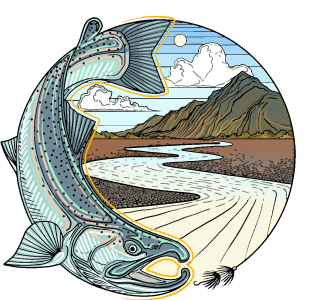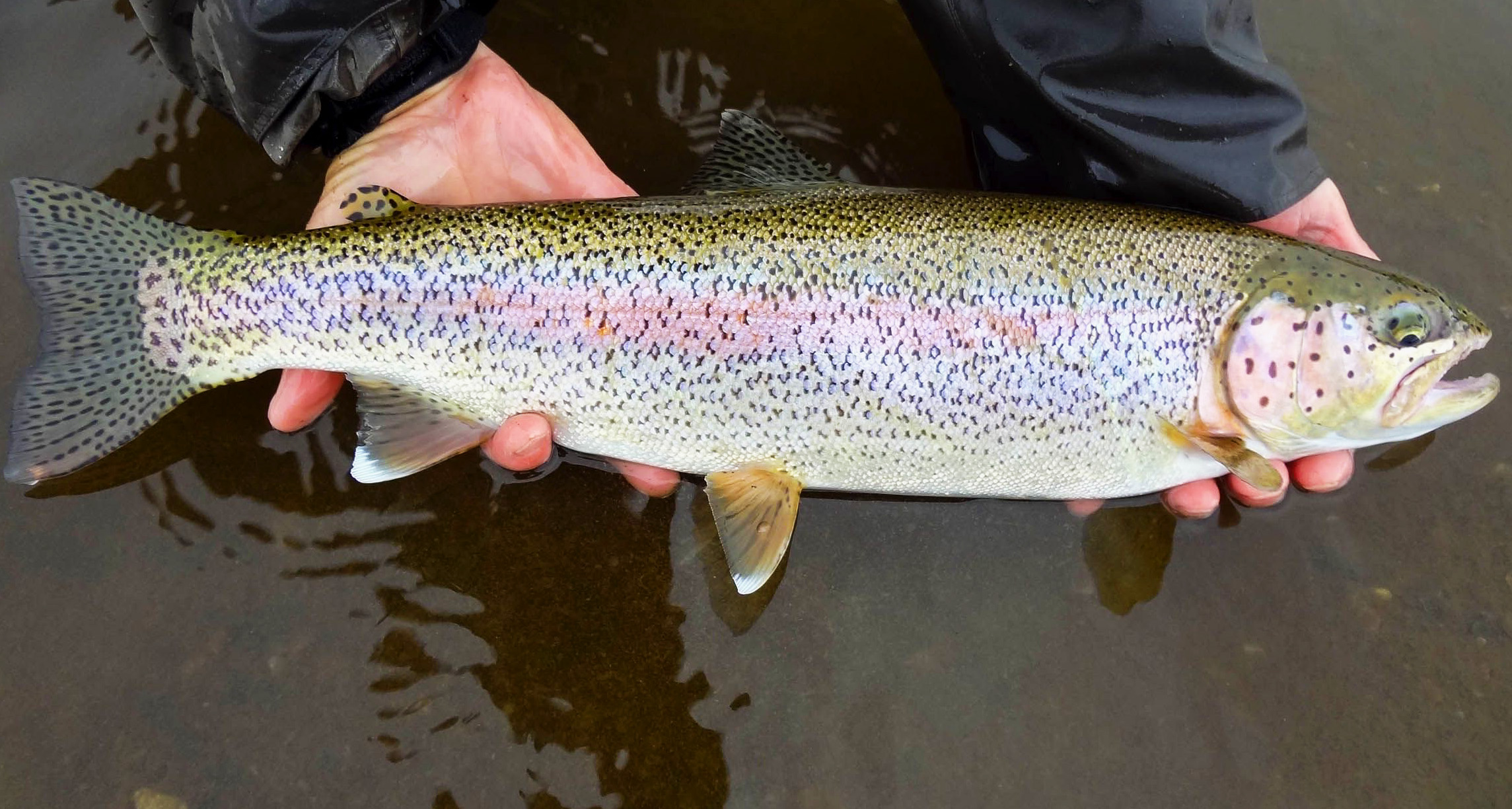by Mike Cole
 As spring nears so does the fishing season. It is time to quit fooling around at the fly tying bench and dust off the rods. A few things come to mind when I think of spring trout: mice and sculpins. Mousing is an exciting way to fish, but if you are looking for more hook-ups than you would get at the local strip club, I suggest looking into the latter. From pounding the banks and snags of the smallest streams to swinging the long gravel bars of rivers like the Kenai, fishing leeches and sculpins is a deadly effective way to catch bows in the spring.
As spring nears so does the fishing season. It is time to quit fooling around at the fly tying bench and dust off the rods. A few things come to mind when I think of spring trout: mice and sculpins. Mousing is an exciting way to fish, but if you are looking for more hook-ups than you would get at the local strip club, I suggest looking into the latter. From pounding the banks and snags of the smallest streams to swinging the long gravel bars of rivers like the Kenai, fishing leeches and sculpins is a deadly effective way to catch bows in the spring.
It is no secret that rainbows feed ferociously after ice out. And that one of the best pattern styles for those early season bows is a black articulated fly or strung-out leech. But why is black so effective? What does that swinging leech really represent? Leeches don’t swim that fast and there are no black bait fish, are there?
 Meet Cottus aleuticus and Cottus cognatus, otherwise known as the Aleutian and Western Slimy Sculpins. Many locals know them as Bullheads or freshwater Irish Lords. These are the two most common species of freshwater sculpins found in Alaska. C. aleuticus is found from the Aleutian Islands up the Alaska Peninsula and into Bristol Bay. C. cognatus is found from Southeast to Southcentral Alaska. These sculpins are scavengers, hiding in all the nooks and crannies of the river and lake bottoms. And unlike Michael Phelps, they suck at swimming. Maybe this is why bows love to hit a sculpin and leech patterns at the end of the swing when the fly slows down and hangs.
Meet Cottus aleuticus and Cottus cognatus, otherwise known as the Aleutian and Western Slimy Sculpins. Many locals know them as Bullheads or freshwater Irish Lords. These are the two most common species of freshwater sculpins found in Alaska. C. aleuticus is found from the Aleutian Islands up the Alaska Peninsula and into Bristol Bay. C. cognatus is found from Southeast to Southcentral Alaska. These sculpins are scavengers, hiding in all the nooks and crannies of the river and lake bottoms. And unlike Michael Phelps, they suck at swimming. Maybe this is why bows love to hit a sculpin and leech patterns at the end of the swing when the fly slows down and hangs.Fishing sculpin and leech patterns is easy. I fish a variety of sink-tips at varying sink rates. Most of the time I fish a 10’ type III tip with a 5-6’ 10 pound leader, but I’ll throw 24’ 300 grain tips with 3’ 15 pound leaders when the situation calls for it. Pounding the banks and ripping the fly over snags is one technique that can result in some violent takes. But when possible I fish the swing. There is something about the “tug” that gives me goose bumps. But that is just the steelheader in me. To fish the swing, you want to cast down and across the river about 45 degrees to the current. Mend up river. Drop your rod tip to the water and follow the line with the rod so that your rod and fly line are inline with each other. Let the fly swing until directly below you and wait at least 5 seconds before you retrieve your line for the next cast. Bows love to follow their prey and hit when the fly comes to a stop.
Floating Flies for Spring Trout and Char
by Mark Hieronymus
In May and June, as spring rapidly gathers momentum, the trout and char of Alaska's numerous watersheds are being roused out of their winter-long state of torpor. For months these fish have been in a metabolic recession, an annual slowing of the body's functions brought on by the onset of winter and the attendant absence of forage. As the days lengthen and the sun's rays begin to melt the ice, water temperatures start to climb. The increase in light and heat brings about a change in the trout and char as their cold-blooded metabolisms begin to speed up - they are now ravenously hungry, and haven't eaten for months.
At the same time the trout and char are "waking up" from their long winter slumber, the offspring of last year's salmon runs are starting their out-migration to salt water. These tiny fry have swum up out of their natal gravel in great numbers, intent upon their journey to the ocean. As they are swept along with the current, into and out of lakes and into estuaries, the hungry trout and char are there to greet them.
To the fly angler, these seasonal awakenings mark the year's first opportunity to cast a fly to the trout and char of Alaska. While many anglers choose to fish beneath the surface of the water, using sinking lines and heavy flies, a small number of fly enthusiasts choose to fish on the surface using dry lines and floating flies. After witnessing a two-foot-long trout inhale half the river with your floating fry, or the vee-wake of a Dolly Varden in frantic pursuit of a stripped slider, you too may want to partake in the thrill of surface angling.
 Other conditions that need to be taken into consideration are wind and turbidity, often linked occurrences on tidewater flats. A little wind is often conducive to fishing surface flies, just enough to lightly ruffle the surface and still allow a fish to track your offering. As the wind increases, the vee-wake and attention-getting splish of your little surface offering is all but negated by more wave action. Occasionally, the increased wave action may make the estuary turbid, and as the water visibility decreases, so do the odds of having a successful surface-fly outing. Look for clear water and light winds for the best chance of success on the surface.
Other conditions that need to be taken into consideration are wind and turbidity, often linked occurrences on tidewater flats. A little wind is often conducive to fishing surface flies, just enough to lightly ruffle the surface and still allow a fish to track your offering. As the wind increases, the vee-wake and attention-getting splish of your little surface offering is all but negated by more wave action. Occasionally, the increased wave action may make the estuary turbid, and as the water visibility decreases, so do the odds of having a successful surface-fly outing. Look for clear water and light winds for the best chance of success on the surface.
Another method of presentation is called swinging, which relies on water flow to imitate the tiny vee-wake of a disoriented salmon smolt at the surface. In this presentation, the fly is cast at angle downstream and allowed to swing back towards shore on a tight line. By varying the downstream angle of the cast between 30° and 60° as well as adding a slight "upstream and out" mend, an angler can control the speed of the swing as well as the effective time the fly spends in a likely holding spot. Don't be afraid to mix up these presentations, occasionally throwing a few line strips into the swing, as often an interested fish will follow a swung fly, waiting and watching for the "panic motion" of a pursued baitfish before it strikes.
 The next time you are out in search of spring trout or char, keep an eye open for signs of surface activity and have a slider or other surface fly handy in case the need arises. When casting to a holding spot, remember to swing or strip your fly from above the fish so they get a good look at your fly as it skitters across the surface towards them. Also, when the moment of truth arrives and you see the surface boil behind your fly, remember to wait for the pull of the fish to set the hook. Trout and char have the habit of short-striking or missing altogether when it comes to surface flies, but they also have short memories and will often strike at a fly 2 or 3 times before being hooked. When you feel the pressure of a fish, raise the rod firmly with a grip on the line...no need for a Bassmasters hook-set as most fish hook themselves, and if the fish misses the hook you want to keep your offering in the water so they can have another go at it.
The next time you are out in search of spring trout or char, keep an eye open for signs of surface activity and have a slider or other surface fly handy in case the need arises. When casting to a holding spot, remember to swing or strip your fly from above the fish so they get a good look at your fly as it skitters across the surface towards them. Also, when the moment of truth arrives and you see the surface boil behind your fly, remember to wait for the pull of the fish to set the hook. Trout and char have the habit of short-striking or missing altogether when it comes to surface flies, but they also have short memories and will often strike at a fly 2 or 3 times before being hooked. When you feel the pressure of a fish, raise the rod firmly with a grip on the line...no need for a Bassmasters hook-set as most fish hook themselves, and if the fish misses the hook you want to keep your offering in the water so they can have another go at it.
While it is not the most effective way to catch large numbers of fish, the rewards of fishing surface flies are a catch in their own right. Seeing the vee-wake of a hungry spring char materialize behind your swung fly or the explosion of water as a hungry trout cuts through the surface to pounce on your slider can be just as good or better as catching of fish, and certainly provide some visual excitement to your spring angling routine. Give surface flies a try this spring, and you might find that you like it on top, too




